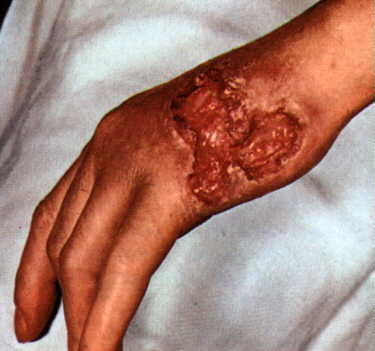Vernereal Syphilis
Primary Syphilis is characterized by a small, painless open sore called a chancre. The chancre usually appears 14-21 days after the initial infection. The single sore is very visible on the penis of males; however, on women it is much harder to spot because it forms on the outer wall of the cervix. Chancres may also form on the labia, scrotum, in the rectum / anus, in the mouth, or on the nipple and usually go unnoticed because they are painless and not easily visible. During this time, the host experiences enlarged lymph nodes in the area containing the chancre. Primary symptoms usually disappear without treatment within three to six weeks and the first chancre is usually gone before the onset of the secondary stages. After no treatment, the chancre heals and leaves behind a slightly depressed scar while the organism continues to multiply in the body. Syphilis reproduces slowly dividing every 30 hours compared to every 20-30 minutes for most bacteria.
Secondary Syphilis is characterized by a general skin rash over the surface of the body, most prevalent on the palms and soles. These symptoms usually start to show six weeks to several months after the initial infection, manifesting as additional sores on the mouth, vagina, and/or penis called mucous patches. The lesions that develop are usually bilateral and symmetrical. By this stage, the spirochete has entered the bloodstream and reproduced rapidly. Fever, loss of appetite, and swollen lymph nodes usually accompany the secondary stage, which is said to affect approximately one-third of untreated individuals. Secondary syphilis is the most contagious stage of syphilis. This stage can stay on the skin anywhere from a few days to a year or more.
Latent Syphilis, by definition, is "hidden syphilis" and is broken into two arbitrary stages: early latent and late latent. Early latent is usually defined as "asymptomatic syphilis of less than four years duration". It begins when the secondary symptoms disappear and ends around four years after the initial infection. After those four years, the late latent period begins and continues throughout life except in those individuals who develop tertiary syphilis (which involves a separate set of symptoms).
Tertiary Syphilis (sometimes called later syphilis) develops when no other prevention treatment has been administered and usually ends in damage to vital organs and eventual death. Pockets of damaged tissue (gummas) develop on or around the skin, bones, heart, arteries, liver, and the nervous system. When the disease develops in the nervous system, it spawns a disease called neurosyphilis. Neurosyphilis has four different manifestations:
- Asymptomatic neurosyphilis presents no symptoms although abnormalities may be present in the cerebral fluid.
- Meningovascular neurosyphilis causes cranial nerve damage, pupil abnormalities, and sometimes stroke.
- Tabes dorsalis is described as a progressive degeneration of the spinal cord thereby causing inability to walk.
- General paresis causes paralysis, tremors, seizures, and general mental decline from damage to brain cells. Gummas form anywhere on the brain or spinal cord therefore causing a variety of neurological defects.
Congenital Syphilis
Congenital Syphilis is passed from mother to fetus and may be active at birth. It is thought that the infection of the fetus occurs during the secondary stage of syphilis when there is the highest frequency of Treponema pallidum circulating in the blood. Possible symptoms developed at birth (or later in infancy) include damage to the eye, uneven spacing of the teeth, poor bone structure, facial scars, and deafness. Congenital syphilis is caused by the untreated infection of the mother only. If left untreated, syphilis is also known to cause a high rate of stillbirth and abortions. Today, congenital syphilis is rarely seen in the general public as prenatal care and effective treatment of the infection exist.









